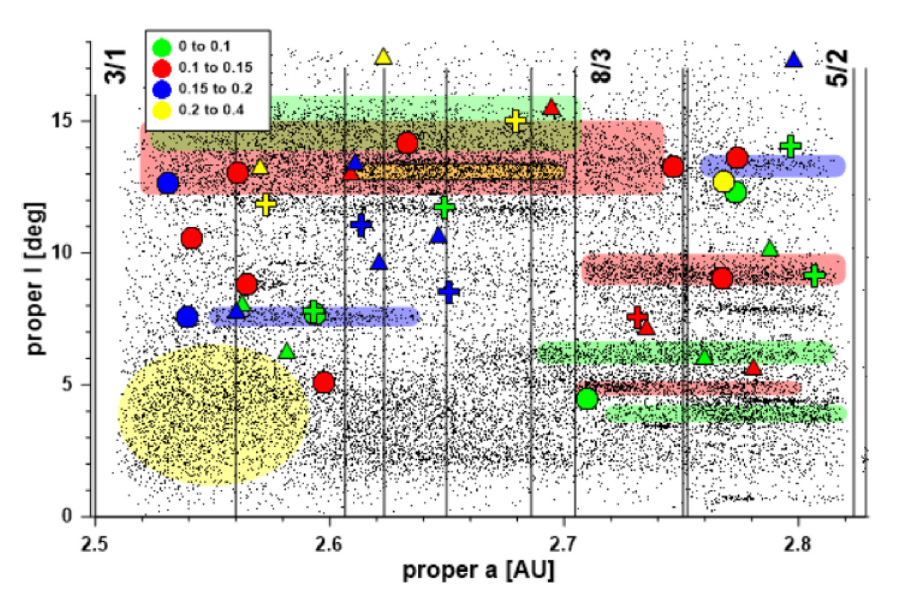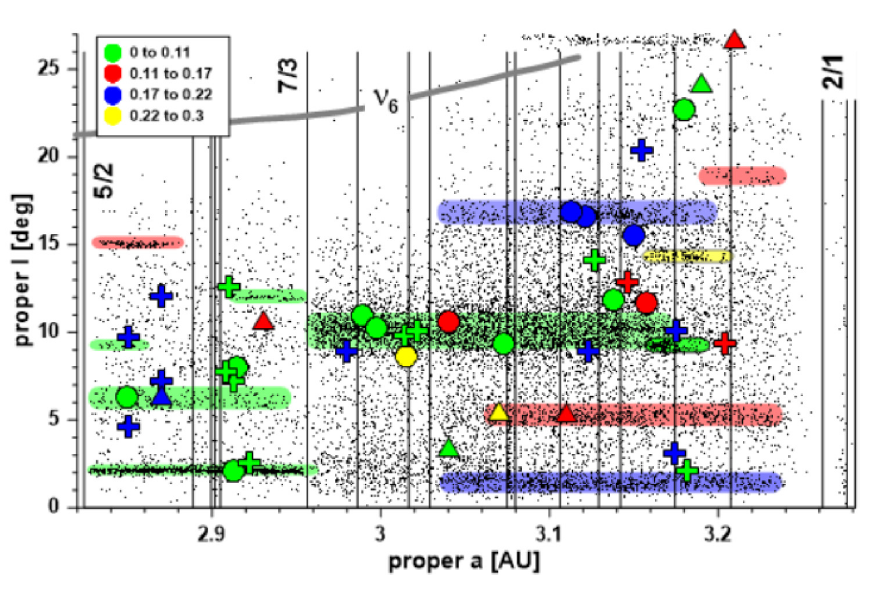Basaltic asteroids beyond 2.5 AU: spectral investigation of asteroid families
- 1IAPS-INAF, via Fosso del Cavaliere 100, 00133, Rome, Italy
- 2IAG, Universidade de Sao Paulo, São Paulo, Brazil
- 3Observatorió Nacional, COAA, Rio de Janeiro, Brazil
- 4Department of Physics and Astronomy ‘G. Galilei’, University of Padova, Padova, Italy
- 5IAC, La Laguna, Spain
Up to now, only (4) Vesta has been identified as the source of differentiated material, which has been discovered all around the Main Belt region. Most of the basaltic asteroids, identified through spectroscopic measurements, are located in the inner main belt region (2.15-2.5AU) and constitute the Vesta family. These asteroids are indeed dynamically linked to Vesta and share similar spectroscopic properties, showing the absorption bands at 0.92-0.94 micron and 2.0 micron, which are indicative of a basaltic composition. From a dynamical point of view, these objects have proper semimajor axis ap, eccentricity ep and inclination ip in the ranges 2.26 < ap < 2.48, 0.075 < ep <0.122 and 5.6° < ip < 7.9°, respectively (Nesvorny et al. 2015). In addition, a faint absorption band at 0.506 micron, due to a spin forbidden transition of Fe2+, was recently detected also in some V-type asteroids, both members and non-members of the Vesta family (Migliorini et al. 2021).
Ground-based observations have shown that few asteroids distributed beyond the 3:1 MMR (Mean Motion Resonance) at 2.5 AU have a basaltic composition (Lazzaro et al. 2000; Hardersen et al. 2004, 2018; Roig et al. 2008; De Sanctis et al. 2011; Solontoi et al. 2012; Ieva et al. 2018; Leith et al. 2017; Migliorini et al. 2018, 2021; Medeiros et al. 2019), although with some differences with respect to Vesta and its family members (Jasmim et al. 2013). Thus, their origin seems to be likely linked to the break-up of large, differentiated objects other than Vesta. Dynamical studies allowed the identification of possible asteroid families, like (221) Eos, (1272) Gefion and (1040) Klumpkea families, which could be the result of the disruption of a differentiated or partly-differentiated parent body. These asteroid families include members with very different spectral types, including basaltic asteroids. Among the asteroids we observed in a previous ground-based campaign, some confirmed V-type asteroids were found to be members of these identified asteroid families, while others lay close to these asteroid families (Migliorini et al. 2021).
In the figure below, confirmed basaltic asteroids located beyond 2.5 AU are shown in the proper a- proper I plane and indicated with a circle. Asteroid families are also marked with different colors. Some objects classified as M- (crosses) and A- type (triangles) are also included.
We started a new observing campaign to spectrally characterize asteroids selected among the above listed asteroid families, aiming to identify other members with a basaltic composition.
In this work we revise the spectral and dynamical properties of basaltic asteroids in the middle and outer main belt, not related to Vesta, and recent observations of asteroids members of the (221) Eos, (1272) Gefion and (1040) Klumpkea families.


Figure 1. a-i plane of proper semimajor axis and inclination of the middle (left) and outer (right) main belt. Basaltic asteroids from Migliorini et al. (2021) are shown with circles. Some are identified as members of the asteroids families shaped with different colors, while some are locate close to these families. Some M- type and A- type asteroids, located in the same region, are also reported with crosses and triangles, respectively, for comparison.
References
De Sanctis M.C. et al. 2011, A&A, 533, A77.
Hardersen P.S. et al. 2004, Icarus, 159, 178.
Hardersen P.S. et al. 2018, AJ, 156, 11.
Ieva S. et al. 2018, MNRAS, 479, 2607.
Jasmim F.L. et al. 2013, A&A, 552, A85.
Lazzaro D. et al. 2000, Science, 288, 2033.
Leith T.B. et al. 2017, Icarus, 205, 61.
Medeiros H. et al. 2019, MNRAS, 488, 3866.
Migliorini A. et al. 2018, MNRAS, 475, 353.
Migliorini A. et al. 2021, MNRAS, 504, 2019.
Nesvorny D. et al. 2015, Asteroids IV, p. 895.
Roig F. et al. 2008, Icarus, 194, 125.
Solontoi M. et al. 2012, Icarus, 218, 571.
How to cite: Migliorini, A., Michtchenko, T., Lazzaro, D., De Sanctis, M. C., Lazzarin, M., La Forgia, F., and Morate, D.: Basaltic asteroids beyond 2.5 AU: spectral investigation of asteroid families, Europlanet Science Congress 2022, Granada, Spain, 18–23 Sep 2022, EPSC2022-318, https://doi.org/10.5194/epsc2022-318, 2022.

